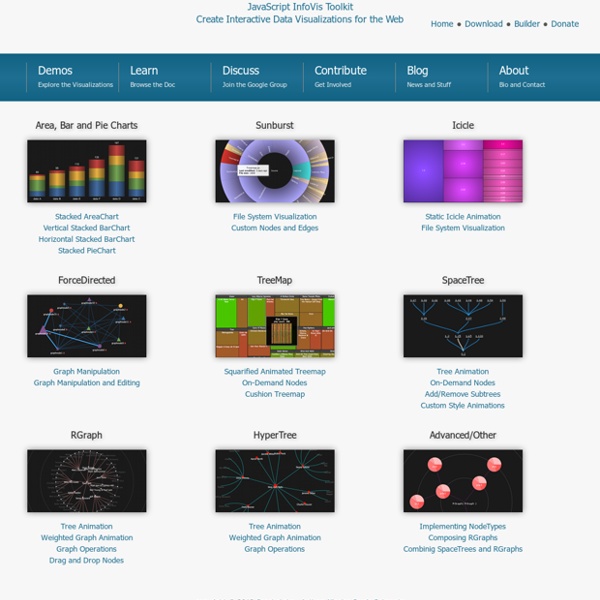



http://philogb.github.io/jit/demos.html
blog Hey friends! I gave in and finally integrated <canvas> support into JSViz, and just in time for the Safari 3 Beta (which I'm really digging so far)! Note: To render with canvas, you'll need Firefox 1.5, Safari 2.0, or Opera 9. 18 Free Mind Mapping Tools for Teachers and Students 1- SpiderScribe This is a great mind mapping tool that allows users to easily visualize their ideas by connecting various pieces of information together and create free style maps. It also combines elements like text, images, files, calendar events and geographic locations.
Visual Tools Tools for Visually displaying RDF Graphs and other things. RDF Gravity is a tool for visualising RDF/OWL Graphs/ ontologiesThe W3C RDF validator is an online service that validates RDF. It also produces images of the graphs using Graphviz when Graph is selected as one of the "Display Result Options".Welkin is a graph-based RDF visualizersgvizler provides a javascript based SPARQL query form that passes the SPARQL result set to a powerful visualizer.Tools for creating SVG Imagesd3.js Data-Driven Documents - a small JavaScript library for manipulating documents based on data.JavaScript InfoVis Toolkit creates interactive data visualizations, e.g. a Force Directed Static Graph and Force Directed Graph Operations. More examples on the demos page.Constructive Solid Geometry (CSG) is a modeling technique that uses Boolean operations like union and intersection to combine 3D solids. Tools ======================================================
Processing.js Demos below! As a sort-of reverse birthday present I’ve decided to release one of my largest projects, in recent memory. This is the project that I’ve been alluding to for quite some time now: I’ve ported the Processing visualization language to JavaScript, using the Canvas element. I’ve been working on this project, off-and-on now, for the past 7 months – it’s been a fun, and quite rewarding, challenge. tagxedo ענן מלים Processing ... Personal $ Svg $20 ✓ Up to $75 merchandises for personal use. home jsPlumb jsPlumb provides a means for a developer to visually connect elements on their web pages. It uses SVG in modern browsers, and VML on IE 8 and below. Cytoscape.js This is how easy it is to get started with Cytoscape.js (this code creates the instance you see on the bottom-right: About Cytoscape.js is an open-source graph theory library written in JavaScript. You can use Cytoscape.js for graph analysis and visualisation. Cytoscape.js allows you to easily display and manipulate rich, interactive graphs.
אוטוקולאז' Graph Graph Description In mathematics and computer science, graph theory studies networks of connected nodes and their properties. A graph can be used to visualize related data, or to find the shortest path from one node to another node for example. Central concepts in graph theory are: Node: a block of information in the network.Edge: a connection between two nodes (can have a direction and a weight).Centrality: determining the relative importance of a node.Clustering: partitioning nodes into groups. arbor.js D3.js - Data-Driven Documents